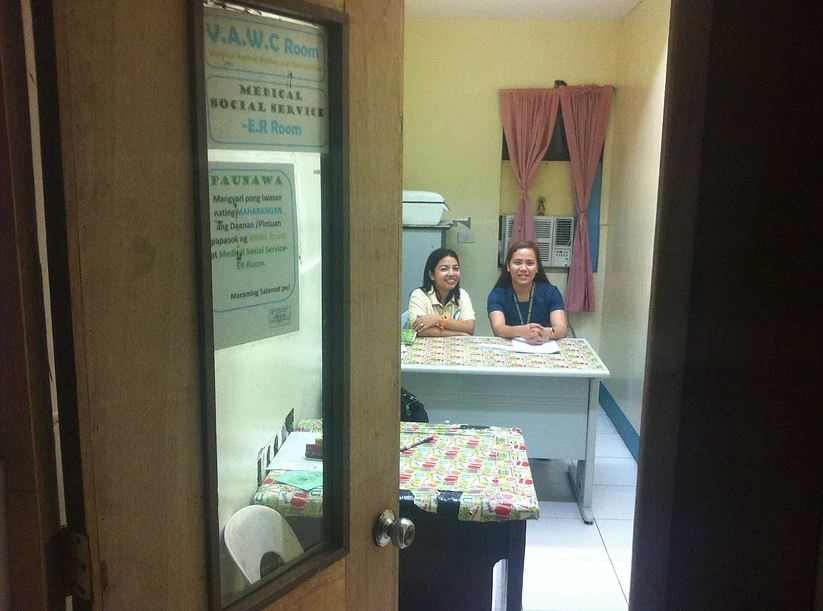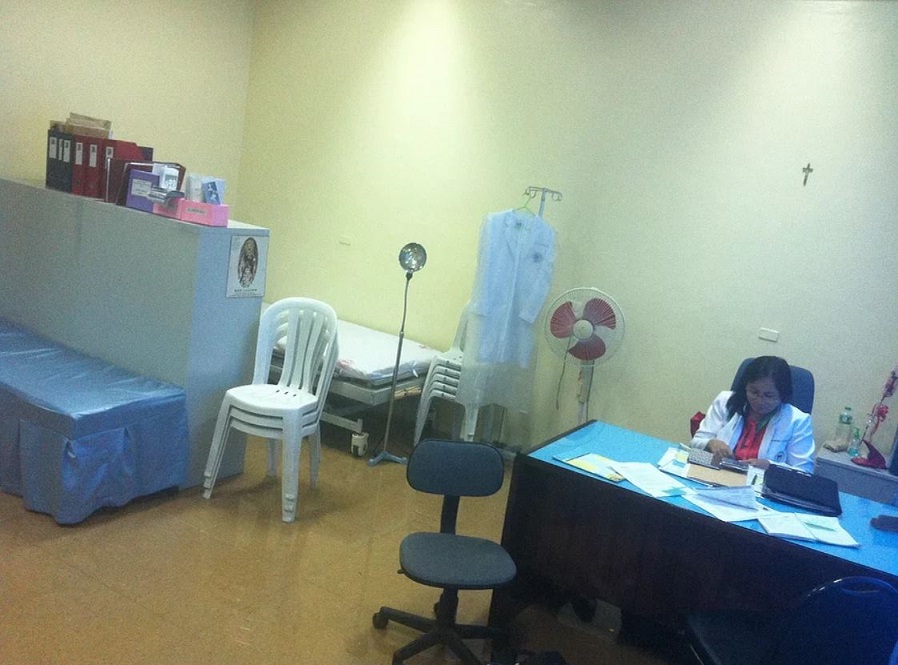One Monday morning in March, a six-year-old girl was brought by her separated parents to the emergency room of the Tondo Medical Center (TMC) in Manila.
Anna (not her real name) had faint scratch marks on her chest and back, and bruises on other parts of her body. When she said her father’s live-in partner has been hurting her, she was immediately admitted to the Women and Children Protection Unit (WCPU), where social worker Jovelyn Montesines asked her a few questions, including how the girl got the bruises, the way she does with all other patients.
She documented Anna’s narration on a standard hospital form, called in her parents and lectured them on child protection laws. But Montesines failed to do an all important thing.
Instead of having a doctor fill out a medico-legal form as per Department of Health (DOH) policy, she ended the interview. She sent Anna home and did not refer her to other hospitals or shelters as she is required to do.

The WCPU in TMC is labeled VAWC room. It is solely administered by social worker Jovelyn Montesines (right), accompanied by a co-worker (left) at the hospital’s medical social services section, who helps her with the unit’s workload.
Four years after the DOH’s Women and Children Protection Program was implemented, TMC and four of the nine Metro Manila DOH hospitals visited for this report have yet to comply with the minimum standards provided for in Administrative Order 2013-0011 signed in 2013.
The protection program requires government hospitals under the DOH to set aside a room that will provide a wide range of medical and social services for abused women and children.
Today, WCPUs are beset with inadequate facilities and equipment and a lack of officers with proper training to handle abuse cases or issue medico-legal forms. Several doctors hesitate because of time constraints or fear of appearing in court.
These were the very same problems that hounded the implementation of AO 1-B, a directive issued in 1997 that first created WCPUs and which the 2013 DOH order sought to revamp, said Rizza Pamintuan of the Philippine General Hospital (PGH) Women’s Desk.
The protection units become ever important following the enactment of the 2004 Anti-Violence Against Women and Children law, which mandates the state to address VAWC.
Official 2016 data from the Philippine National Police (PNP) show the total number of cases of violence against women, including rape and other related cases, VAWC cases and other forms of harassment against women, have doubled after 2013.
In 2014, there were 49,883 cases nationwide, a 51 percent increase from 25,430 cases in 2013.
AO 2013-0011 provides a manual that classifies these protection units by level and specifies standards each must meet, including personnel, training, research and services.
A first-level WCPU should be able to give medico-legal forms as evidence should victims decide to file a case in court. A second-level WCPU must have, in addition to these, police officers, mental healthcare officers and 24/7 social work intervention. A third-level WCPU must provide all these, plus give training to other hospitals.
Officers at the three levels must undergo the DOH’s 4Rs trainings—recognition, reporting, recording and referral of abuse cases, apart from officers being ready to give testimony in court.
Montesines is the lone member of Tondo Medical Center’s WCPU, which became operational in 2014. The hospital immediately assigned her as WCPU coordinator, her very first job at TMC when she joined in August of that year.
She also assists dozens of poor patients who avail themselves of subsidies every day, like discounts in medicines. To help her, other social workers also interview abuse patients per hospital protocol, all without training.
Montesines herself has never attended a 4Rs training. She said the only seminar she went to was an orientation on DOH’s registry system in 2014. Participants were only required to be adept at using a computer.
Without any training, Montesines was clueless on what to do.“It’s different if you have training on patient handling. In-depth work, that’s where we lack,” she said. “That’s why I can’t say what
At the Philippine Orthopedic Center (POC), a DOH hospital in Quezon City, no such room exists. “We don’t have a WCPU,” appointed head Dr. Angela Garcia said in April.
The hospital is willing to create one, but she said circumstances would not permit it. A small room intended as WCPU had been turned into a blood bank, as some areas of the hospital emergency room are under construction.
Like Montesines, Garcia said she knows the ideal setup, but the lack of “commitment from people who will handle the unit” has also stalled its creation.
She attended a 4Rs training, but the pediatrician assigned to the WCPU never did, citing various excuses, Garcia said. Three nurses and two social workers supposedly assigned to the WCPU have other roles in the hospital too. Garcia herself is head of two other hospital committees, among others.
In Santa Cruz, Manila, WCPU officers of Dr. Jose Fabella Memorial Hospital and San Lazaro Hospital (SLH), specialized hospitals on maternity and infectious diseases, are also at a loss, fumbling through the positions they were assigned in 2016.
Fabella is one of 79 functioning WCPUs in the PGH-CPU’s 2015 booklet. But WCPU head Dr. Maria Theresa Razo said in an interview the committee was only formed in 2016 with little to start with.
“It’s hard to set ideal WCPUs,” she said. “First, we’d have to request for the materials.”
 The WCPU at San Lazaro Hospital is a huge room with a comfort room and bed. Dr. Maria Divina Valerio, the unit head, sits on her desk.
The WCPU at San Lazaro Hospital is a huge room with a comfort room and bed. Dr. Maria Divina Valerio, the unit head, sits on her desk.
Dr. Maria Divina Valerio, WCPU head of SLH since December 2015, said the unit has tallied 22 cases of abused children from 2016 up till March 2017, based on reports ofcheckups they have registered at patient admission or referrals from nearby hospitals.
Her office records cases so the abused can avail of the free services like testing for sexually transmitted diseases, she said in an interview last March. A spacious unit located near the emergency room, complete with exam tables, beds and other equipment, lies idle.
“I don’t do this as a job. I do this as a mission,” said Valerio. “If one way of helping patients is to ease their burden by talking to them, at least we are here. Otherwise, they would not know where to go.”
Fabella and RMC had functional WCPUs once. Fabella’s was located beside the emergency room of the hospital back in 2008, Razo said, but its emergency room needed widening, and the WCPU had been sacrificed.
At the Rizal Medical Center (RMC) in Pasig City, most doctors turn their backs on going to court hearings, said Dr. Nelinda Pangilinan, head of the Obstetrics-Gynecology (OB-Gyn) Department, which supervises the WCPU.
It’s a question of time for RMC doctors. They are reluctant. “We would delegate our time to be witness,” said Pangilinan.
More, the lack of proper training has led doctors to treat victims on condition that they will be admitted only for medical services, said Argent Dulig, resident doctor at RMC.
She once referred a four-year-old sexually abused girl to PNP at Camp Crame when the mother said she was bent on filing cases. “I told them Camp Crame’s women’s desk can assist them better,” Dulig said. “The process would be faster and with proper procedures.”
At TMC in Manila, Montesines is hopeful her office will improve in time. Training will come, she said, but for now they want to focus on creating an official committee. She has been lobbying for it with the chief of the Medical Social Services. “I just don’t know what the status is,” she said.
“There’s no coordination,” Pangilinan added. “The policy had no teeth to force you to follow.”
With WCPUs at TMC and similar hospitals sending cases like Anna home right away instead of to another hospital—even as they give referral forms—it is difficult to find out if the victims ever get the help they need.
“They come here seeking help, and yet we cannot provide it. Instead of helping the person, maybe we do more damage,” Dulig said.
“It’s hard on our part. Are we really helping them?” Montesines finds herself asking.
(To be concluded)
This two-part story is based on the author’s undergraduate thesis, “For the Children of Eve: An Investigative Study on the Implementation of Women and Children Protection Program in Selected Metro Manila Government Hospitals” done under the supervision of University of the Philippines journalism professor Yvonne T. Chua from January to May 2017.
